March 8th, 2013 by thapke
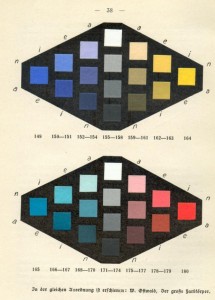 “Von der Kunst zur Wissenschaft und zurück : Farbenlehre und Ästhetik bei Wilhelm Ostwald (1853 – 1932) – From art to science and backward: theory of color and aesthetics by Wilhelm Ostwald (1853 – 1932)”
“Von der Kunst zur Wissenschaft und zurück : Farbenlehre und Ästhetik bei Wilhelm Ostwald (1853 – 1932) – From art to science and backward: theory of color and aesthetics by Wilhelm Ostwald (1853 – 1932)”
is the title of a new doctoral thesis in German language by Albrecht Pohlmann, 1910, University of Halle.
It describes also Ostwald’s activities with the Bridge, the Munich "Institute for the Organization of Intelellectual Work" (Chapter 4. 2. 2) and contains some further chapters of interest also for media historians like chapter 8.3. "The copied image" and others.
Wilhelm Ostwald (1853-1932), who was awarded the Nobel Prize in Chemistry in 1909, is among the scientists who have devoted themselves to the principles of visual design. This dissertation comprehensively represents, for the first time, the genesis of his colour theory in the scientific, art political, art historical and aesthetic context of its time. Since 1903 he devoted himself to painting technique, and finally, in 1914, he developed a colour atlas on behalf of the Deutscher Werkbund. His aim was to create an authoritative colour system as a means of understanding for artists, designers and architects, given the confusingly large amount of new colourants. Ostwald established a new theory of body colours based upon the four-colour theorem of Ewald Hering, which made it possible to measure colours in a simple manner. At the same time, from the organizing principles of his colour system (a colour solid in the form of a double cone) he developed a colour harmony. After World War I, he encountered protest of expressionist artists. Constructivists and functionalists took particular interest in his theories, such as with the Dutch ‘De-Stijl’ group, the Russian avant-garde movement and at the Bauhaus, where Ostwald taught in 1927 at the invitation of Walter Gropius. The main objective of his art technological research was to create a universal grammar of visual media in the era of the second technological revolution, hence his interest in photography, abstract film and picture transmission. The reproducibility of works of art appeared to him to be the requirement of a democratic society. His practical art technological experiments were embedded in a comprehensive art and media theory, which Ostwald had developed on the basis of his “Energetics” (1891) and his positivist “Philosophy of Nature” (1902).
July 16th, 2011 by thapke
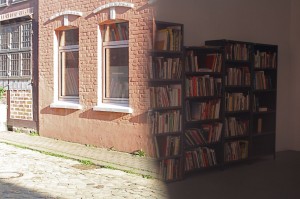 In the end of June 2011 my attention was called to a talk with the title "Unpacking a library" which was given by an art historian Magnus Schäfer from Berlin on the oocasion of an exhibition titled "Dealing with – some books, viusals, and works related to the American Fine Arts, Co." which took place in Lüneburg in the small "Halle für Kunst (Hall of Art) Lüneburg" accompanied by the Kunstraum of the Leuphana University in Lüneburg. The photo with the view on the library was taken from outside the "Halle der Kunst" when looking through the window from the Baumstraße, one of Lüneburg’s beautiful, old streets! The Baumstraße itself is an artwork containing the so-called "Steinmeile" (Mile of Stones).
In the end of June 2011 my attention was called to a talk with the title "Unpacking a library" which was given by an art historian Magnus Schäfer from Berlin on the oocasion of an exhibition titled "Dealing with – some books, viusals, and works related to the American Fine Arts, Co." which took place in Lüneburg in the small "Halle für Kunst (Hall of Art) Lüneburg" accompanied by the Kunstraum of the Leuphana University in Lüneburg. The photo with the view on the library was taken from outside the "Halle der Kunst" when looking through the window from the Baumstraße, one of Lüneburg’s beautiful, old streets! The Baumstraße itself is an artwork containing the so-called "Steinmeile" (Mile of Stones).
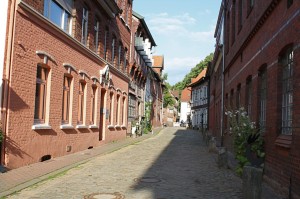
Before I knew nothing about the New York gallery American Fine Arts, Co. which was founded and headed by Colin de Land (1955-2003)! But I was attracted by the Walter Benjamin quote in the title of the talk. Through the talk and the visit of the exhibition I learnt that the library of the gallery has been transferred to Germany and was shown during the exhibiton. During the talk and the discussion afterwards interesting statements and questions have been raised:
- Has the collection/library lost its subject when the galery was closed after the dead of the founder?
- The statement "The library is a document" brought to my mind Michael Buckland’s papers "What is a document?" and "What is a ‘digital document’?"
- When is a collection of books called a library?
- The American Fine Arts library has also been used a little bit like a public library when artists borrowed books for their work.
- The library now, can it be viewed itself as a work of art, as an artifact?
- Can the library now be viewed as self-contained actant in the sense of Bruno Latour? (See also a post about Latour in my German blog)
- The smallest book in the library has been a little books about dogs, "Das kleine Hundebuch" from the publisher Heyne, which was shown during the talk.
More on the gallery American Fine Arts, Co. see here: "American Fine Arts – If culture means anything" curated by James Fuentes, essay by Jackie McAllister.
May 29th, 2011 by thapke
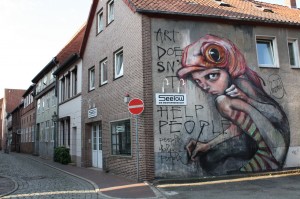 By an English friend I was pointed to a graffiti which exists in Lüneburg, the town where I live, and which was done in 2009 within an Urban Art Project by the Leuphana University. It was created by two artists which call themselves Herakut and contained the text "Art doesn`t help people, people help people".
By an English friend I was pointed to a graffiti which exists in Lüneburg, the town where I live, and which was done in 2009 within an Urban Art Project by the Leuphana University. It was created by two artists which call themselves Herakut and contained the text "Art doesn`t help people, people help people".
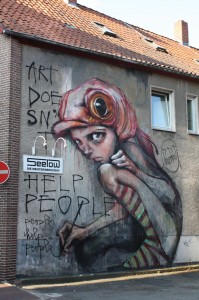 But art is made by people, isn’t it!?
But art is made by people, isn’t it!?
Some videos on this special piece of art and also the descriptions of the other artworks can be viewed at the website.
The art project was "part of Leuphana University’s orientation programme for new students".
Starting their study at Leuphana, students have the so-called Leuphana Semester which is unique for German universities and also includes special introductions into scholarly work as well as the promotion of information literacy.
December 4th, 2008 by thapke
Chemist and Nobel laureate Roald Hoffmann published an article on “combinatorical chemistry” with the title “Not a Library” in the journal Angewandte Chemie (International edition), 40(18), 3337-3340 (2001), which also mentioned Ramon Llull, Leibniz and the “Library of Babel” from Borges.

The article is available at the personal website of Roald Hoffmann who contains some further interesting articles on art or poetry and science, teaching and research, e.g.:
September 26th, 2008 by thapke
 Ostwald’s theory of forms has been the topic of a recent entry in the blog of Joost Rekveld.
Ostwald’s theory of forms has been the topic of a recent entry in the blog of Joost Rekveld.
In the writings of the film maker Joost Rekveld articles can be found with titles like “Symmetry and Harmonics” or “Transformations of Colour”.
August 14th, 2008 by thapke
Just published: The Unimaginable Mathematics of Borges’ Library of Babel by William Goldbloom Bloch (Oxford University Press 2008). The Library of Babel has a lot to do with combinatorics. Jorge Luis Borges‘ essay was influenced by another one by the German Kurd Lasswitz, the father of modern “science fiction”: Die Universalbibliothek (The universal library).
See also Catarina Caetano da Rosa’s German paper with the title “Bibliotheken von Babel: Wunsch- und Albtraum des unendlichen Wissensraumes (Libraries of Babel: great dream and nightmare of the infinite knowledge space)” at the Workshop called “Architekturen der digitalen Weltbibliothek aus historischer und aktueller Perspektive (Architectures of the digital world library from a historical and actual view)” at a computer sciences conference in Germany in 2007 (37. Jahrestagung der Gesellschaft für Informatik (GI)).
July 8th, 2008 by thapke
The aesthetics of networks: A conceptual approach toward visualizing the composition of the Internet by M.K. Sterpka, in: First Monday, volume 12, number 9 (September 2007)
Hierarchy is an entrenched social concept. The Internet however, presents the possibility of envisioning social relations as a level or ‘flat’ configuration. The Internet fosters relationships that are networked, heterogeneous and horizontally distributed. This article contemplates the surface features of networked structures like the Internet by using topographic imagery.
June 18th, 2008 by thapke
Here is the trial, made quick&dirty, using a tool to compile a word cloud from the text of this weblog! Easy and funny! 😎

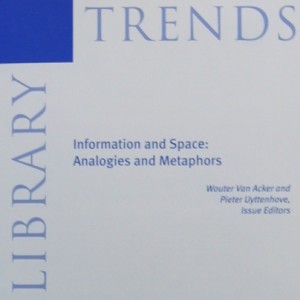 Five years after the “Analogous Spaces” conference its proceedings has been published with the title “Information and Space: Analogies and Metaphors” in a special issue of the journal “Library Trends” (Volume 61, Number 2, Fall 2012)
Five years after the “Analogous Spaces” conference its proceedings has been published with the title “Information and Space: Analogies and Metaphors” in a special issue of the journal “Library Trends” (Volume 61, Number 2, Fall 2012)








